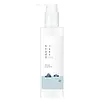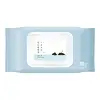What's inside
What's inside
 Key Ingredients
Key Ingredients

 Benefits
Benefits

 Concerns
Concerns

No concerns
 Ingredients Side-by-side
Ingredients Side-by-side

Water
Skin ConditioningEthylhexyl Palmitate
EmollientGlycerin
HumectantDecyl Glucoside
CleansingCetyl Ethylhexanoate
EmollientDiisostearyl Malate
EmollientArachidyl Alcohol
EmollientSea Water
HumectantHyaluronic Acid
HumectantHydrolyzed Hyaluronic Acid
HumectantSodium Hyaluronate
HumectantCeramide NP
Skin ConditioningCeramide Ns
Skin ConditioningCeramide AP
Skin ConditioningCeramide As
Skin ConditioningCeramide EOP
Skin ConditioningPhytosphingosine
Skin ConditioningDipotassium Glycyrrhizate
HumectantAllantoin
Skin ConditioningPanthenol
Skin ConditioningGlyceryl Stearate
EmollientEthylhexylglycerin
Skin ConditioningGlucose
HumectantDipropylene Glycol
HumectantArachidyl Glucoside
EmulsifyingHydroxyacetophenone
AntioxidantSodium Stearoyl Glutamate
CleansingAcrylates/C10-30 Alkyl Acrylate Crosspolymer
Emulsion StabilisingCaprylyl Glycol
EmollientButylene Glycol
HumectantHydrogenated Lecithin
EmulsifyingRosmarinus Officinalis Leaf Oil
MaskingCitrus Aurantium Bergamia Fruit Oil
MaskingLavandula Hybrida Oil
EmollientJuniperus Virginiana Oil
MaskingStearic Acid
CleansingTocopherol
Antioxidant1,2-Hexanediol
Skin ConditioningXanthan Gum
EmulsifyingDisodium EDTA
Cetearyl Alcohol
EmollientBehenyl Alcohol
EmollientCholesterol
EmollientCitric Acid
BufferingWater, Ethylhexyl Palmitate, Glycerin, Decyl Glucoside, Cetyl Ethylhexanoate, Diisostearyl Malate, Arachidyl Alcohol, Sea Water, Hyaluronic Acid, Hydrolyzed Hyaluronic Acid, Sodium Hyaluronate, Ceramide NP, Ceramide Ns, Ceramide AP, Ceramide As, Ceramide EOP, Phytosphingosine, Dipotassium Glycyrrhizate, Allantoin, Panthenol, Glyceryl Stearate, Ethylhexylglycerin, Glucose, Dipropylene Glycol, Arachidyl Glucoside, Hydroxyacetophenone, Sodium Stearoyl Glutamate, Acrylates/C10-30 Alkyl Acrylate Crosspolymer, Caprylyl Glycol, Butylene Glycol, Hydrogenated Lecithin, Rosmarinus Officinalis Leaf Oil, Citrus Aurantium Bergamia Fruit Oil, Lavandula Hybrida Oil, Juniperus Virginiana Oil, Stearic Acid, Tocopherol, 1,2-Hexanediol, Xanthan Gum, Disodium EDTA, Cetearyl Alcohol, Behenyl Alcohol, Cholesterol, Citric Acid
Water
Skin ConditioningMethylpropanediol
SolventDipropylene Glycol
HumectantPolyglyceryl-6 Caprylate
EmulsifyingSea Water
HumectantSodium Hyaluronate
HumectantSodium Acetylated Hyaluronate
HumectantHydrolyzed Hyaluronic Acid
HumectantAllantoin
Skin ConditioningDipotassium Glycyrrhizate
HumectantPanthenol
Skin ConditioningMaltodextrin
AbsorbentSodium Metabisulfite
AntioxidantProtease
ExfoliatingPolyglyceryl-4 Caprate
EmulsifyingSodium Citrate
BufferingHydroxyacetophenone
AntioxidantDecylene Glycol
Skin ConditioningLaurylpyridinium Chloride
AntimicrobialLevulinic Acid
PerfumingSodium Levulinate
Skin ConditioningDisodium EDTA
1,2-Hexanediol
Skin ConditioningCitric Acid
BufferingWater, Methylpropanediol, Dipropylene Glycol, Polyglyceryl-6 Caprylate, Sea Water, Sodium Hyaluronate, Sodium Acetylated Hyaluronate, Hydrolyzed Hyaluronic Acid, Allantoin, Dipotassium Glycyrrhizate, Panthenol, Maltodextrin, Sodium Metabisulfite, Protease, Polyglyceryl-4 Caprate, Sodium Citrate, Hydroxyacetophenone, Decylene Glycol, Laurylpyridinium Chloride, Levulinic Acid, Sodium Levulinate, Disodium EDTA, 1,2-Hexanediol, Citric Acid
 Reviews
Reviews

Ingredients Explained
These ingredients are found in both products.
Ingredients higher up in an ingredient list are typically present in a larger amount.
1,2-Hexanediol is a synthetic liquid and another multi-functional powerhouse.
It is a:
- Humectant, drawing moisture into the skin
- Emollient, helping to soften skin
- Solvent, dispersing and stabilizing formulas
- Preservative booster, enhancing the antimicrobial activity of other preservatives
Allantoin is a soothing ingredient known for its protective and moisturizingg properties. Because of this, it is often added to products with strong active ingredients.
Studies show higher concentrations of this ingredient can promote wound healing.
Though it can be derived from the comfrey plant, allantoin is produced synthetically for cosmetic products to ensure purity.
Learn more about AllantoinCitric Acid is an alpha hydroxy acid (AHA) naturally found in citrus fruits like oranges, lemons, and limes.
Like other AHAs, citric acid can exfoliate skin by breaking down the bonds that hold dead skin cells together. This helps reveal smoother and brighter skin underneath.
However, this exfoliating effect only happens at high concentrations (20%) which can be hard to find in cosmetic products.
Due to this, citric acid is usually included in small amounts as a pH adjuster. This helps keep products slightly more acidic and compatible with skin's natural pH.
In skincare formulas, citric acid can:
While it can provide some skin benefits, research shows lactic acid and glycolic acid are generally more effective and less irritating exfoliants.
Most citric acid used in skincare today is made by fermenting sugars (usually from molasses). This synthetic version is identical to the natural citrus form but easier to stabilize and use in formulations.
Read more about some other popular AHA's here:
Learn more about Citric AcidDipotassium Glycyrrhizate comes from licorice root.
Extracts of licorice have demonstrated to have antibacterial, anti‐inflammatory, antiviral, antioxidant properties.
One component, glabridin, has extra potent antioxidant and soothing properties. It has also been found to block pigmentation from UVB rays in guinea pigs.
Licorice Root also contains a flavonoid. Flavonoids are a natural substance from in plants. Flavonoids also have antioxidant properties.
Another component, glycyrrhizin, has been found to have anti-inflammatory and antimicrobial benefits. This may make licorice root extract effective at treating acne. However, more research is needed to support this.
Liquiritin is one of the flavone compounds found in licorice. It has been found to help lighten skin by preventing tyrosinase from reacting with tyrosine. When the two react, protein is converted to melanin. Melanin is the substance in your body that gives your features pigmentation.
Licorice root is native to Southern Europe and Asia. It has been used in traditional Chinese medicine to help with respiratory issues.
Learn more about Dipotassium GlycyrrhizateDipropylene Glycol is a synthetically created humectant, stabilizer, and solvent.
This ingredient helps:
Dipropylene glycol is technically an alcohol, but it belongs to the glycol family (often considered part of the ‘good’ alcohols). This means it is hydrating and gentle on skin unlike drying solvent alcohols like denatured alcohol.
As a masking agent, Dipropylene Glycol can be used to cover the smell of other ingredients. However, it does not have a scent.
Studies show Dipropylene Glycol is considered safe to use in skincare.
Learn more about Dipropylene GlycolDisodium EDTA plays a role in making products more stable by aiding other preservatives.
It is a chelating agent, meaning it neutralizes metal ions that may be found in a product.
Disodium EDTA is a salt of edetic acid and is found to be safe in cosmetic ingredients.
Learn more about Disodium EDTAHydrolyzed Hyaluronic Acid is a form of hyaluronic acid. It is created by the hydrolysis of hyaluronic acid with a high molecular weight. Once created, Hydrolyzed Hyaluronic Acid has a low molecular weight.
Low molecular weight HA has been shown to hydrate and increase elasticity of the skin. Increasing elasticity is also associated with reduction of wrinkle depth.
One study found topical low molecular weight hyaluronic acid may be considered for the treatment of rosacea in the adult population. However, we always recommend speaking with a professional about your skin concerns.
Hyaluronic acids are a humectant. This means they draw moisture from the air. Hyaluronic acids help moisturize, soothe, and protect the skin.
Read more about other common forms of hyaluronic acid:
Learn more about Hydrolyzed Hyaluronic AcidHydroxyacetophenone is antioxidant with skin conditioning and soothing properties. It also boosts the efficiency of preservatives.
This ingredient is not irritating or sensitizing.
Panthenol is a common ingredient that helps hydrate and soothe the skin. It is found naturally in our skin and hair.
There are two forms of panthenol: D and L.
D-panthenol is also known as dexpanthenol. Most cosmetics use dexpanthenol or a mixture of D and L-panthenol.
Panthenol is famous due to its ability to go deeper into the skin's layers. Using this ingredient has numerous pros (and no cons):
Like hyaluronic acid, panthenol is a humectant. Humectants are able to bind and hold large amounts of water to keep skin hydrated.
This ingredient works well for wound healing. It works by increasing tissue in the wound and helps close open wounds.
Once oxidized, panthenol converts to pantothenic acid. Panthothenic acid is found in all living cells.
This ingredient is also referred to as pro-vitamin B5.
Learn more about PanthenolSodium Hyaluronate is hyaluronic acid's salt form. It is commonly derived from the sodium salt of hyaluronic acid.
Like hyaluronic acid, it is great at holding water and acts as a humectant. This makes it a great skin hydrating ingredient.
Sodium Hyaluronate is naturally occurring in our bodies and is mostly found in eye fluid and joints.
These are some other common types of Hyaluronic Acid:
Learn more about Sodium HyaluronateWater. It's the most common cosmetic ingredient of all. You'll usually see it at the top of ingredient lists, meaning that it makes up the largest part of the product.
So why is it so popular? Water most often acts as a solvent - this means that it helps dissolve other ingredients into the formulation.
You'll also recognize water as that liquid we all need to stay alive. If you see this, drink a glass of water. Stay hydrated!
Learn more about Water